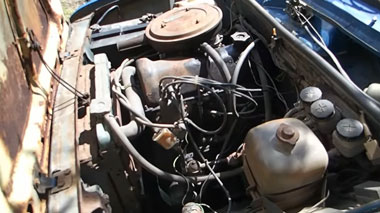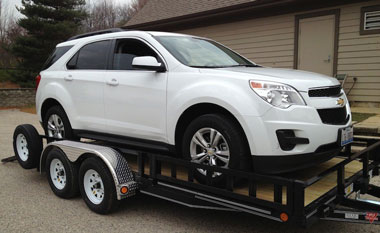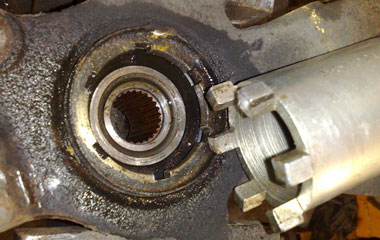
Transmission fluid is one of the most important fluids in your car. It keeps your car’s transmission cool and lubricated, and helps prevent wear and tear. But can you top off transmission fluid?
The answer is yes, but there are a few things you need to know first.
- If the transmission fluid level is low, it can cause the transmission to overheat and eventually fail
- To prevent this from happening, it is important to keep the transmission fluid level topped off
- Here are a few steps on how to top off transmission fluid:
- Park the car on a level surface and put it in neutral
- Pop the hood and locate the transmission dipstick
- Pull out the dipstick and wipe it clean with a rag
- Insert the dipstick all the way back in and then pull it out again to check the fluid level
- If the fluid level is below the “full” line, you will need to add more fluid
- Remove the cap from the transmission fluid reservoir and slowly pour in more fluid until it reaches the “full” line on the dipstick
Do You Leave the Car Running When Adding Transmission Fluid
If your car has an automatic transmission, you should check the fluid level at least once a month. The best time to do this is when the engine is warm. You’ll find the dipstick near where the transmission meets the engine block.
To get an accurate reading, remove the dipstick and wipe it clean with a rag. Then reinsert it and pull it out again to check the fluid level. If it’s low, add transmission fluid until it reaches the “full” line on the dipstick.
It’s important not to overfill your transmission, so only add a small amount at a time and recheck the level after each addition. When adding fluid, be sure to use a product that’s specified for your car – typically Dexron II, III or VI ATF (automatic transmission fluid). You can find this information in your owner’s manual or by asking a clerk at an auto parts store.
Do You Add Transmission Fluid Where the Dipstick is
Adding transmission fluid is an important part of maintaining your car. The transmission is a key component of your car’s engine, and without proper maintenance, it can lead to big problems down the road. One way to keep your transmission in good shape is to regularly check the level of fluid using the dipstick.
If the level is low, you’ll need to add more fluid. But where do you add it? The answer may surprise you – you actually add transmission fluid where the dipstick is located!
There is a small fill hole next to the dipstick that allows you to add fluid without removing any parts. If you’re not sure how to locate the fill hole or how much fluid to add, consult your car’s owner’s manual.
It’s always better to err on the side of caution when it comes to adding fluids, so if you’re unsure, take your car to a mechanic and have them do it for you.

Can I Add Transmission Fluid Without Flushing
If your transmission is running low on fluid, you may be wondering if you can add transmission fluid without flushing the system. The answer is yes, you can add transmission fluid without flushing, but it’s not recommended.
If your transmission is low on fluid, it’s likely because there’s a leak somewhere in the system.
Adding more fluid will just temporarily mask the problem and could actually make it worse by overworking the seals and gaskets.
The best way to deal with a leaking transmission is to have it repaired or replaced as soon as possible. In the meantime, you can top off the fluid level to keep things running smoothly.
Just be sure to check the level frequently and don’t let it get too low again.
Transmission Fluid Top off near Me
If you’re looking for a transmission fluid top off near me, there are a few things to keep in mind. First, transmission fluids should be checked regularly and topped off as needed to keep your car running smoothly. Second, most auto parts stores carry transmission fluids and will be able to help you find the right one for your car.
Finally, if you’re not sure how to check or fill your transmission fluid, most mechanics will be able to do it for you.
How to Check Transmission Fluid
If your car has an automatic transmission, then it likely has a dipstick to check the transmission fluid level. This is a simple process that anyone can do at home with just a few tools.
Here’s how to check your transmission fluid level:
First, find the dipstick and remove it from the engine. The dipstick will have markings on it that indicate the full and low levels of transmission fluid. Next, clean off the end of the dipstick with a rag or paper towel.
Reinsert the dipstick into the engine and pull it out again. Check the level of fluid on the dipstick and compare it to the markings. If it’s below the “low” mark, then you need to add more fluid.
To add fluid, simply open up the hood and locate the transmission fluid reservoir (it will have a label). Remove the cap and pour in enough new fluid until it reaches the “full” mark on the dipstick. Checking your transmission fluid level regularly is an important part of preventative maintenance for your car.
By keeping an eye on this vital component, you can avoid serious problems down the road!

Can You Add Transmission Fluid When the Car is Hot
Adding transmission fluid when your car is hot is not recommended. The heat can cause the fluid to break down and lose its lubricating properties. If you must add fluid, do so slowly and carefully.
How to Add Transmission Fluid Without Dipstick
If your car is low on transmission fluid, you may be wondering how to add transmission fluid without a dipstick. The good news is that it’s actually not that difficult – all you need is a funnel and some fresh transmission fluid.
To start, locate the transmission fluid fill port.
This will usually be somewhere near the top of the engine, on the side of the transmission. Once you’ve found it, insert the funnel into the fill port and slowly pour in your new transmission fluid until it reaches the full line on the dipstick (if your car has one).
It’s important to use fresh fluid when topping off your transmission, as old or contaminated fluid can cause problems down the road.
If you’re unsure of what type of fluid to use, consult your car’s owner’s manual or ask a qualified mechanic.
How to Change Transmission Fluid
If your car is starting to have transmission problems, it may be time to change the fluid. Luckily, this is a relatively easy process that you can do at home. Here’s how to change your car’s transmission fluid:
1. Park your car on a level surface and put it in neutral. Then, engage the parking brake.
2. Locate the transmission dipstick and remove it.
Wipe off the dipstick with a clean cloth or paper towel.
3. Insert a funnel into the transmission fill hole and pour in new transmission fluid until it reaches the “full” line on the dipstick.
4. Replace the dipstick and screw on the fill hole cap tightly.
Lower your car back down from its jack stands and take it for a test drive!
Can I Just Top off Transmission Fluid?
Transmission fluid is one of the most important fluids in your car, and it needs to be changed regularly to keep your car running smoothly. You should never just top off your transmission fluid, as this can damage your transmission and lead to expensive repairs.
If you’re low on transmission fluid, you need to add more until you reach the full line on the dipstick.
Be sure to use the correct type of transmission fluid for your car – if you’re unsure, consult your owner’s manual or a mechanic.
Can I Just Add Transmission Fluid Instead of Changing It?
There are a lot of transmission fluids on the market and they all have different properties. Some are designed to work with specific types of transmissions and some are not. If you use the wrong type of fluid, it can actually damage your transmission.
The most common type of transmission fluid is automatic transmission fluid (ATF). It is a thin, clear liquid that has a slightly sweet smell. ATF is what’s known as a “hydraulic fluid” because it helps to move parts in the transmission using hydraulic pressure.
Over time, ATF breaks down and gets dirty. When this happens, it can cause problems with your transmission like shifting issues or even complete failure. That’s why it’s important to change your ATF every 30,000 miles or so.
You can’t just add new ATF to old ATF – you need to completely flush out the old stuff first. Otherwise, you’ll end up with a mixture of old and new fluids that won’t work well together. The best way to do this is to take your car to a mechanic and have them do it for you.
If you’re experiencing problems with your transmission, changing the fluid is definitely something you should try before anything else. It’s relatively inexpensive and easy to do, so it’s worth a shot!
Can I Add Transmission Fluid If Its Low?
Yes, you can add transmission fluid if it’s low. You’ll need to check your owner’s manual to find out what kind of fluid to use and how much to add. Adding transmission fluid is a pretty easy task, so don’t be afraid to do it yourself.
Can I Top off My Transmission Fluid Without Changing It?
It is generally not recommended to “top off” your transmission fluid without changing it. Transmission fluid should be changed according to the manufacturer’s recommendations (usually around 30,000 miles). When you do change your transmission fluid, all of the old, dirty fluid should be drained out and new, clean fluid added.
Topping off your transmission fluid with fresh fluid without changing all of the old fluid first can actually cause more harm than good because it can create a sludge that will clog up your transmission.
Penrite DIY How to Top Up Your Automatic Transmission Fluid
Conclusion
If your car’s transmission is running low on fluid, you may be wondering if it’s okay to just top it off. The answer is maybe. It depends on how low the fluid level is and what kind of transmission you have.
If the level is very low, it’s best to add a bit more than what you need so that the pump can fill up the entire system. However, if you have an automatic transmission, it’s not recommended to add too much fluid as it could cause damage.






































